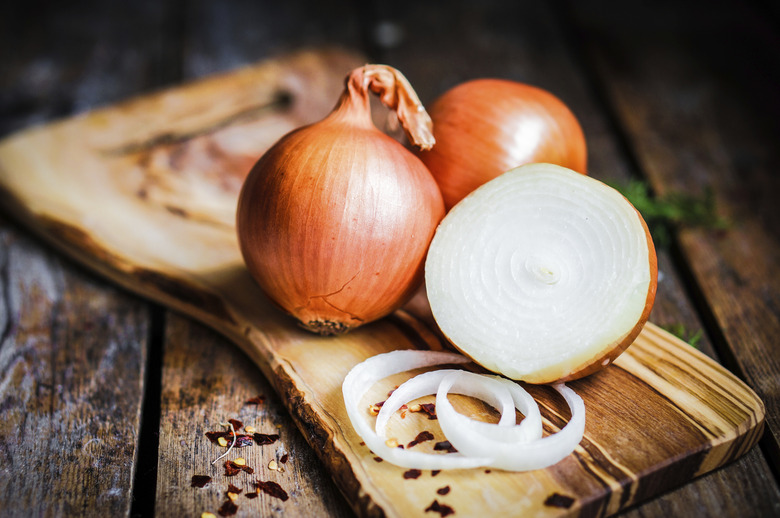The Cell Structure Of An Onion
Onions have a long history of human use, originating in southwestern Asia but having since been cultivated across the world. Their strong odor — actually a defense mechanism — and unique structure belie a complex internal makeup, composed of cell walls, cytoplasm, and the vacuole. As onions can be found in almost every grocery store or easily grown independently, educators tend to use them when students learn about plant biology, thanks also in part to their easily-seen cell walls.
Plant Cells and Animal Cells
Plant Cells and Animal Cells
Plant cells are distinct from animal cells: plant cells have rigid cell walls, rather than the more flexible cell membranes of animal cells. The cell walls are high in cellulose, a material that gives rigidity to the cell and which, when accumulated in large amounts in many cells, provides the strength and rigidity of everything from flower stems to tree trunks. Plant cells have one large vacuole — a large open area central to the cell which is used as a reservoir for water and ions, and in certain cases for storage of toxins. While animal cells may have vacuoles, they are not present as a single, large, central reservoir but as several lesser reservoirs distributed through the cell. Plant cells also have chloroplasts: these are organelles containing chlorophyll in systemic arrays to capture light and convert it to glucose.
Cell Walls Give Structure
Cell Walls Give Structure
Cell walls in plants are rigid, compared to other organisms. The cellulose present in the cell walls forms clearly defined tiles. In onion cells the tiles look very similar to rectangular bricks laid in offset runs. The rigid walls combined with water pressure within a cell provide strength and rigidity, giving plants the necessary structure to resist gravity and pressure. The cell walls and the pressure from water contained in both cytoplasm and more particularly in the vacuole are what give onion its solid substance and crisp snap.
Cytoplasm
Cytoplasm
Sandwiched between the vacuole and the cell wall is the cytosol. The cytosol is primarily water, salts and a variety of organic molecules serving various functions in relation to the cell and the greater organism. Within the cytosol are organelles: organic structures that serve as factories, communications centers and other functional elements in the management of the cell metabolism. Also floating within the cytosol are inclusions consisting of a range of elements, starches, proteins and other molecules used as building blocks for a range of functions. Also contained within the cytoplasm of the plant cell is the nucleus, containing the primary genetic material of the plant.
Vacuole
Vacuole
Vacuoles contain the necessary water, ions and a range of organic molecules produced by the plant, in many cases including those for pigment, or chemicals that produce the distinctive scent or flavor of a plant. In onions, the vacuole is very large and distinct. The characteristic scent of onions is produced by the combination of flavor precursors present as organic molecules in the cytoplasm, and a secondary organic chemical, the enzyme allinase, which is contained and restricted to the vacuole of the onion. Only when the onion is damaged by cutting, bruising, the attack of insects or rodents or through some similar mechanical destruction are the precursors and the allinase combined, forming a powerful scent. Similarly, in red onions, the coloration of the onion is contained within the vacuole.
A Classic Subject for Study
A Classic Subject for Study
Onion cells are among the most common choices for cell studies in early biology classes. Easily obtained, inexpensive, they offer samples with no difficult technique required. The thin layer of skin found on the inside of an onion scale (one layer of onion) lifts off without effort and can be wet mounted on a slide with no need for extreme skill. Likewise, the cells are large, regular, easily seen and conform very well with the standard generic elements of all plant cells. The growing tips of onion roots are similarly used as classic subjects when observing meiosis, for similar reasons of easy access and easy handling by novices. Onions, coupled with apples, potatoes and elodea leaves, are among the most reliable and useful of lab subjects when teaching new students the fundamentals of biology and the foundational skills of working in a biology lab.
Cite This Article
MLA
Robinson, Peg. "The Cell Structure Of An Onion" sciencing.com, https://www.sciencing.com/cell-structure-onion-5438440/. 11 July 2019.
APA
Robinson, Peg. (2019, July 11). The Cell Structure Of An Onion. sciencing.com. Retrieved from https://www.sciencing.com/cell-structure-onion-5438440/
Chicago
Robinson, Peg. The Cell Structure Of An Onion last modified August 30, 2022. https://www.sciencing.com/cell-structure-onion-5438440/
